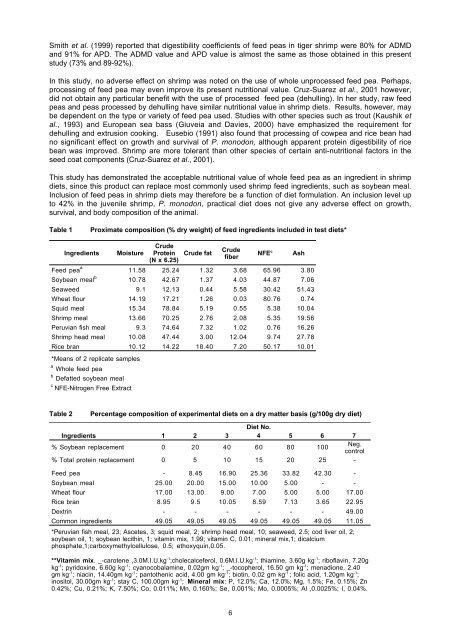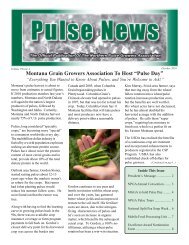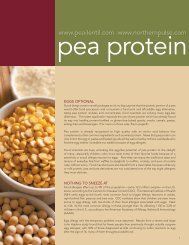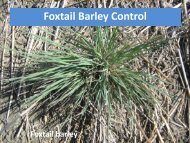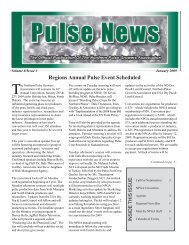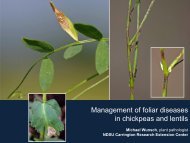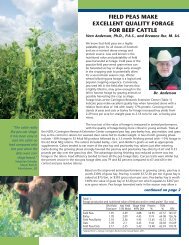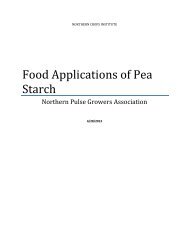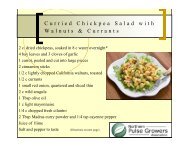Feed Peas in diets for shrimp tilapia and milkfish - Northern Pulse ...
Feed Peas in diets for shrimp tilapia and milkfish - Northern Pulse ...
Feed Peas in diets for shrimp tilapia and milkfish - Northern Pulse ...
You also want an ePaper? Increase the reach of your titles
YUMPU automatically turns print PDFs into web optimized ePapers that Google loves.
Smith et al. (1999) reported that digestibility coefficients of feed peas <strong>in</strong> tiger <strong>shrimp</strong> were 80% <strong>for</strong> ADMD<strong>and</strong> 91% <strong>for</strong> APD. The ADMD value <strong>and</strong> APD value is almost the same as those obta<strong>in</strong>ed <strong>in</strong> this presentstudy (73% <strong>and</strong> 89-92%).In this study, no adverse effect on <strong>shrimp</strong> was noted on the use of whole unprocessed feed pea. Perhaps,process<strong>in</strong>g of feed pea may even improve its present nutritional value. Cruz-Suarez et al., 2001 however,did not obta<strong>in</strong> any particular benefit with the use of processed feed pea (dehull<strong>in</strong>g). In her study, raw feedpeas <strong>and</strong> peas processed by dehull<strong>in</strong>g have similar nutritional value <strong>in</strong> <strong>shrimp</strong> <strong>diets</strong>. Results, however, maybe dependent on the type or variety of feed pea used. Studies with other species such as trout (Kaushik etal., 1993) <strong>and</strong> European sea bass (Giuveia <strong>and</strong> Davies, 2000) have emphasized the requirement <strong>for</strong>dehull<strong>in</strong>g <strong>and</strong> extrusion cook<strong>in</strong>g. Eusebio (1991) also found that process<strong>in</strong>g of cowpea <strong>and</strong> rice bean hadno significant effect on growth <strong>and</strong> survival of P. monodon, although apparent prote<strong>in</strong> digestibility of ricebean was improved. Shrimp are more tolerant than other species of certa<strong>in</strong> anti-nutritional factors <strong>in</strong> theseed coat components (Cruz-Suarez et al., 2001).This study has demonstrated the acceptable nutritional value of whole feed pea as an <strong>in</strong>gredient <strong>in</strong> <strong>shrimp</strong><strong>diets</strong>, s<strong>in</strong>ce this product can replace most commonly used <strong>shrimp</strong> feed <strong>in</strong>gredients, such as soybean meal.Inclusion of feed peas <strong>in</strong> <strong>shrimp</strong> <strong>diets</strong> may there<strong>for</strong>e be a function of diet <strong>for</strong>mulation. An <strong>in</strong>clusion level upto 42% <strong>in</strong> the juvenile <strong>shrimp</strong>, P. monodon, practical diet does not give any adverse effect on growth,survival, <strong>and</strong> body composition of the animal.Table 1Proximate composition (% dry weight) of feed <strong>in</strong>gredients <strong>in</strong>cluded <strong>in</strong> test <strong>diets</strong>*IngredientsMoistureCrudeProte<strong>in</strong>(N x 6.25)Crude fatCrudefiberNFE c<strong>Feed</strong> pea a 11.58 25.24 1.32 3.68 65.96 3.80Soybean meal b 10.78 42.67 1.37 4.03 44.87 7.06Seaweed 9.1 12.13 0.44 5.58 30.42 51.43Wheat flour 14.19 17.21 1.26 0.03 80.76 0.74Squid meal 15.34 78.84 5.19 0.55 5.38 10.04Shrimp meal 13.66 70.25 2.76 2.08 5.35 19.56Peruvian fish meal 9.3 74.64 7.32 1.02 0.76 16.26Shrimp head meal 10.08 47.44 3.00 12.04 9.74 27.78Rice bran 10.12 14.22 18.40 7.20 50.17 10.01*Means of 2 replicate samplesa Whole feed peab Defatted soybean mealcNFE-Nitrogen Free ExtractAshTable 2Percentage composition of experimental <strong>diets</strong> on a dry matter basis (g/100g dry diet)Diet No.Ingredients 1 2 3 4 5 6 7% Soybean replacement 0 20 40 60 80 100Neg.control% Total prote<strong>in</strong> replacement 0 5 10 15 20 25 -<strong>Feed</strong> pea - 8.45 16.90 25.36 33.82 42.30 -Soybean meal 25.00 20.00 15.00 10.00 5.00 - -Wheat flour 17.00 13.00 9.00 7.00 5.00 5.00 17.00Rice bran 8.95 9.5 10.05 8.59 7.13 3.65 22.95Dextr<strong>in</strong> - - - - - - 49.00Common <strong>in</strong>gredients 49.05 49.05 49.05 49.05 49.05 49.05 11.05*Peruvian fish meal, 23; Ascetes, 3; squid meal, 2; <strong>shrimp</strong> head meal, 10; seaweed, 2.5; cod liver oil, 2;soybean oil, 1; soybean lecith<strong>in</strong>, 1; vitam<strong>in</strong> mix, 1.99; vitam<strong>in</strong> C, 0.01; m<strong>in</strong>eral mix,1; dicalciumphosphate,1;carboxymethylcellulose, 0.5; ethoxyqu<strong>in</strong>,0.05.**Vitam<strong>in</strong> mix. _-carotene ,3.0M.I.U.kg -1 ;cholecalceferol, 0.6M.I.U.kg -1 ; thiam<strong>in</strong>e, 3.60g kg -1 ; riboflav<strong>in</strong>, 7.20gkg -1 ; pyridox<strong>in</strong>e, 6.60g kg -1 ; cyanocobalam<strong>in</strong>e, 0.02gm kg -1 ; _-tocopherol, 16.50 gm kg -1 ; menadione, 2.40gm kg -1 ; niac<strong>in</strong>, 14.40gm kg -1 ; pantothenic acid, 4.00 gm kg -1 ; biot<strong>in</strong>, 0.02 gm kg -1 ; folic acid, 1.20gm kg -1 ;<strong>in</strong>ositol, 30.00gm kg -1 ; stay C, 100.00gm kg -1 ; M<strong>in</strong>eral mix: P, 12.0%; Ca, 12.0%; Mg, 1.5%; Fe, 0.15%; Zn0.42%; Cu, 0.21%; K, 7.50%; Co, 0.011%; Mn, 0.160%; Se, 0.001%; Mo, 0.0005%; Al ,0.0025%; I, 0.04%.6


